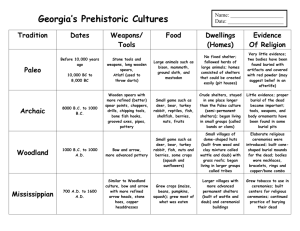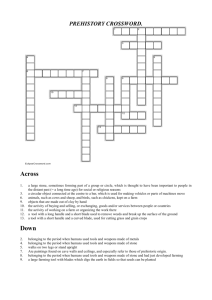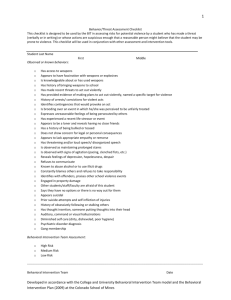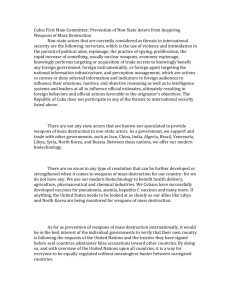Air Force Real Property Agency (AFRPA)
advertisement
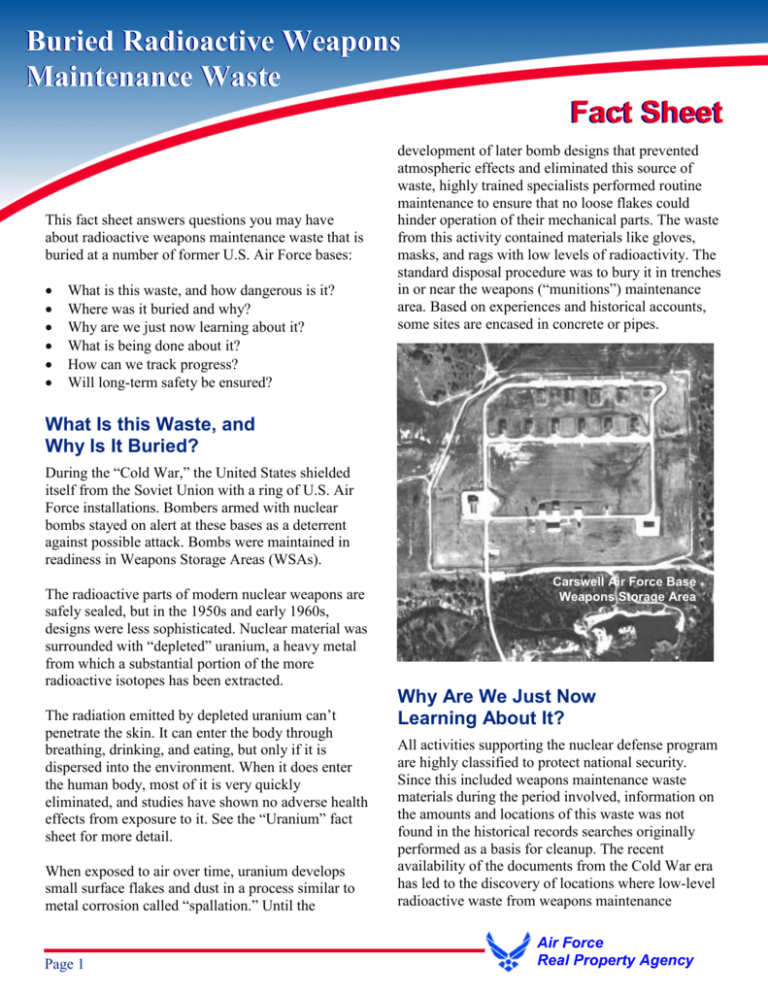
Buried Radioactive Weapons Maintenance Waste Fact Sheet Sheet Fact This fact sheet answers questions you may have about radioactive weapons maintenance waste that is buried at a number of former U.S. Air Force bases: What is this waste, and how dangerous is it? Where was it buried and why? Why are we just now learning about it? What is being done about it? How can we track progress? Will long-term safety be ensured? development of later bomb designs that prevented atmospheric effects and eliminated this source of waste, highly trained specialists performed routine maintenance to ensure that no loose flakes could hinder operation of their mechanical parts. The waste from this activity contained materials like gloves, masks, and rags with low levels of radioactivity. The standard disposal procedure was to bury it in trenches in or near the weapons (“munitions”) maintenance area. Based on experiences and historical accounts, some sites are encased in concrete or pipes. What Is this Waste, and Why Is It Buried? During the “Cold War,” the United States shielded itself from the Soviet Union with a ring of U.S. Air Force installations. Bombers armed with nuclear bombs stayed on alert at these bases as a deterrent against possible attack. Bombs were maintained in readiness in Weapons Storage Areas (WSAs). The radioactive parts of modern nuclear weapons are safely sealed, but in the 1950s and early 1960s, designs were less sophisticated. Nuclear material was surrounded with “depleted” uranium, a heavy metal from which a substantial portion of the more radioactive isotopes has been extracted. The radiation emitted by depleted uranium can’t penetrate the skin. It can enter the body through breathing, drinking, and eating, but only if it is dispersed into the environment. When it does enter the human body, most of it is very quickly eliminated, and studies have shown no adverse health effects from exposure to it. See the “Uranium” fact sheet for more detail. When exposed to air over time, uranium develops small surface flakes and dust in a process similar to metal corrosion called “spallation.” Until the Page 1 Carswell Air Force Base Weapons Storage Area Why Are We Just Now Learning About It? All activities supporting the nuclear defense program are highly classified to protect national security. Since this included weapons maintenance waste materials during the period involved, information on the amounts and locations of this waste was not found in the historical records searches originally performed as a basis for cleanup. The recent availability of the documents from the Cold War era has led to the discovery of locations where low-level radioactive waste from weapons maintenance Air Force Real Property Agency activities may have been buried in the WSAs. In response, the Air Force Safety Center (AFSC) immediately began a vigorous process to research old records and interview retirees to identify where these activities may have occurred. Where Is Weapons Maintenance Waste Buried? AFSC personnel worked with staff from the national nuclear weapons laboratories to determine which munitions could have generated the waste in question. AFSC then asked the Defense Threat Reduction Agency, which maintains the nation’s classified nuclear weapons databases, to determine at which Air Force installations the weapon systems had been deployed. This investigation identified a number of sites where past practices might have included burying low-level weapons maintenance waste. Most of these sites are on installations that are still active; however, some installations are undergoing the Base Realignment and Closure (BRAC) process managed by the Air Force Real Property Agency (AFRPA), and some sites on them may have been closed and returned to local authority. AFSC contacted retired nuclear weapons maintenance specialists who worked at the AFRPA installations during the relevant period. This information, along with historical documents, was used to locate possible waste burial sites. The locations of weapons storage areas at the BRAC bases are known and either remain under military ownership or have been remediated. Others are undergoing site investigations as part of the Air Force’s ongoing environmental restoration program. What’s the Danger? Potential waste burial sites are unlikely to present any immediate health risk if not disturbed, and impacts to the groundwater are not anticipated. Nevertheless, these sites may not meet the criteria for release to other owners for unrestricted use, and certainly all parties need more information to assess potential risk and plan any advisable future actions. Page 2 Because the Air Force has already transferred some property at some of these bases, AFRPA is taking prompt measures to ensure that any previously unknown waste burial sites are not disturbed until potential risks, including that to groundwater, can be determined. It is quite possible that no waste burial sites will be found, that the type and level of radioactivity found in a site will be at harmless levels, or that controls already in place are adequately protective of human health and the environment. What’s Being Done About It? With the support of the Air Force Institute for Operational Health (AFIOH), AFRPA will determine whether radioactive materials are present and, if so, clean up these sites to acceptable levels. The plan that will be used is based on the approach developed by multiple federal regulatory agencies (Environmental Protection Agency, Nuclear Regulatory Commission, Department of Energy, National Aeronautics and Space Administration, and Department of Defense) and documented in the Multi-Agency Radiation Survey and Site Investigation Manual (MARSSIM) for conducting radiation surveys and investigations. The process, including activities to inform and involve interested parties in the public, will be consistent with the one set out by the Comprehensive Environmental Response, Compensation, and Liability Act (CERCLA), commonly known as the “Superfund” law, which is the framework for the evaluation and cleanup of chemical contaminants at Air Force installations. There are five phases of planned activities— planning, implementation, scoping surveys, characterizations surveys, and response actions. The initial evaluation will include the first three phases: PHASE I. Planning Tasks Restrict access to potential sites—Appropriate steps will be taken to restrict the WSA sites to prevent any accidental digging or exposure. Collect information for each installation— Background information is needed for each installation as a basis for determining the work to be performed at each installation. This task will Air Force Real Property Agency Storage Vault in a Weapons Storage Area include evaluating all prior radiological-related response actions at each installation, identifying prior environmental actions within the WSAs and determining the property transfer and reuse status of the WSA properties. Review radiological decommissioning surveys for WSA facilities—Radiological decommissioning surveys of WSA facilities conducted in the early 1990s will be reviewed to ensure that survey assumptions, monitoring procedures, and survey conclusions support the transfer of WSA facilities for reuse activities and to determine what facilities, if any, need to be resurveyed. Reevaluate all radiological sources and remedial actions taken—Conduct additional records reviews and retiree interviews to ensure that all sources and potential releases of radiological wastes have been evaluated and remediated. This effort will focus on operations that may have used radiological materials in areas where burial may have occurred. Any information from this effort will be integrated into the ongoing environmental program of the appropriate installation. Review environmental restoration documents prepared for previously conducted or planned remedial actions—This review will both ensure the adequacy of prior response actions and provide a context for planning and executing response actions at AFRPA installations. Page 3 PHASE II. Preimplementation Tasks Prepare site investigation work plans— Outlines of the process for initial investigation of potential burial sites will be used to provide advance information prior to the surveys. Conduct information meetings with stakeholders—Meetings at each installation will brief the operating staff, cleanup team members, regulatory agencies, the local redevelopment authority, and the Restoration Advisory Board about the planned investigations. PHASE III. Site Investigation Tasks Conduct Surveys—Site investigations that don’t involve digging (“nonintrusive” techniques) will be conducted where potential burial sites have been identified. Conduct clearance surveys of WSA facilities— Wherever needed, additional measurements of radiation levels will be taken to certify that the facility is safe. Prepare preliminary assessment/site investigation report—Background and environmental information, potential migration pathways and receptors, and scoping survey results will be documented in the report. Restrict access to identified sites (as required)—Appropriate steps will be taken to restrict (or further restrict) access, including fencing, signing, and security patrols, where appropriate. Based on the result of the site investigation, additional site characterization and/or removal actions (cleanup) may be warranted. How Can We Track Progress? As investigation, evaluation, planning, and response proceed, senior military leaders, environmental regulators, and elected officials will be kept fully informed. With the help of the local Restoration Advisory Board, if still active, the Air Force will actively communicate findings, plans, and accomplishments to local redevelopment authorities, property owners, and the public. Air Force Real Property Agency Will Long-Term Safety Be Ensured? The Air Force is committed to properly identifying, evaluating, and remediating radiological wastes to protect human health and the environment. CONTACTS Placeholder for AFRPA contact information Organization Address Address Phone, E-Mail Placeholder for local contact information Organization Address Address Phone, E-Mail Version 1—May 8, 2003 Page 4 Air Force Real Property Agency


